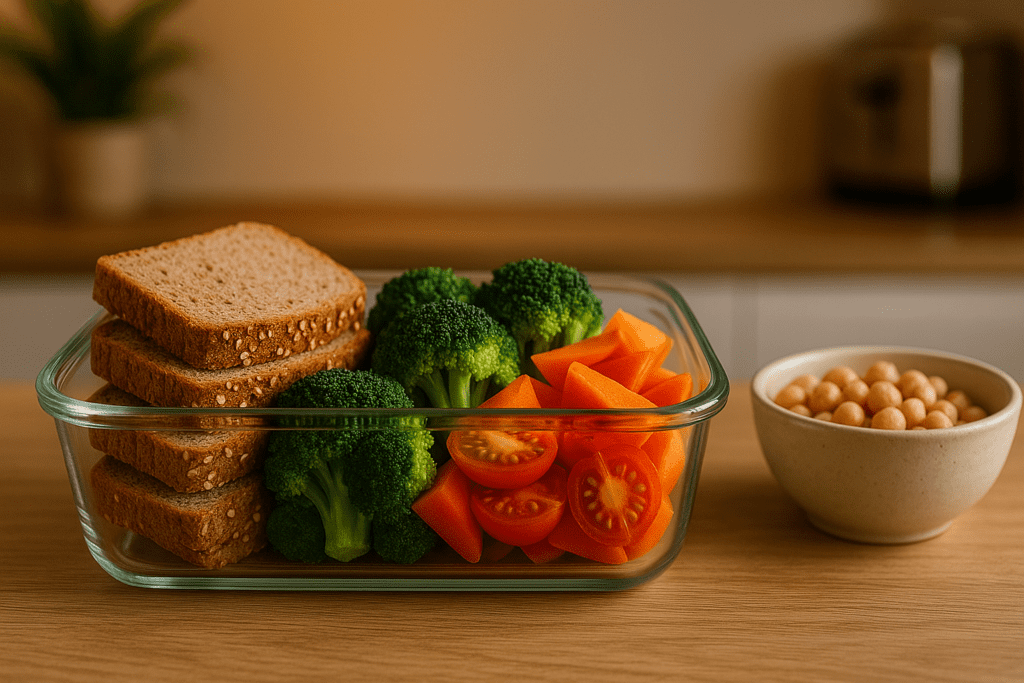Navigating the world of food as an adult with selective eating habits can be both frustrating and isolating. Unlike children, adults who are picky eaters often face additional layers of societal expectations, dietary responsibilities, and limited time due to demanding work schedules. The challenge is compounded by the pressure to maintain a balanced diet, adhere to health recommendations, and embrace meal diversity. Unfortunately, mainstream nutrition advice frequently fails to address the nuanced needs of this group, leaving many feeling left out of the healthy eating conversation. This article explores creative, nutritious, and accessible lunch ideas for picky eaters adults can confidently enjoy while providing evidence-based insights that align with mindful eating principles and a healthier lifestyle.
You may also like: Smart Healthy Eating Tips for Busy Professionals: How to Stay Nourished When You’re Always on the Go
Understanding Adult Picky Eating: More Than Just “Being Fussy”
Picky eating in adulthood is often misunderstood as a character flaw or a refusal to try new things. In reality, it may stem from deeply rooted psychological associations with certain textures, flavors, or food experiences. For some, it’s linked to sensory processing differences or past negative experiences with food during childhood. Others may simply have highly specific taste preferences that limit their willingness to experiment with unfamiliar dishes. Regardless of the cause, these eating patterns can lead to nutritional imbalances, social discomfort during shared meals, and feelings of guilt or shame around eating behaviors.
What’s crucial to understand is that adult picky eating does not necessarily mean a person is unhealthy or unmotivated to eat better. In many cases, individuals are eager to improve their diets but lack guidance tailored to their specific challenges. Creating satisfying meals for picky eaters adults can enjoy begins with empathy and the recognition that every food preference is valid. With the right approach, even selective eaters can build a nourishing, diverse lunch routine that promotes health without forcing dietary overhauls.
Reframing Nutrition for Picky Eaters: A Flexible Approach
Traditional dietary advice often emphasizes variety, color, and the inclusion of all food groups. While these guidelines are well-intentioned, they may unintentionally alienate individuals who find certain food groups difficult to tolerate. For example, a person who dislikes most vegetables may feel overwhelmed when told that a healthy plate should be half-filled with them. The key to long-term nutritional success for selective eaters lies in reframing food choices within the boundaries of personal comfort.
Instead of focusing on what is missing, it is more productive to emphasize what can be included. For instance, if raw vegetables are off-putting, cooked or pureed options might be more acceptable. If a person dislikes the texture of whole grains, milder options like white rice or whole-wheat pasta can serve as transitional foods. Even foods that seem “plain” can be nutritious when thoughtfully prepared. Customizing meals for picky eaters adults can feel confident in requires creativity, patience, and a non-judgmental mindset. Health doesn’t require a radical transformation—it can start with small, manageable adjustments that honor individual tastes.

Smart Swaps and Ingredient Innovations
One effective strategy for overcoming picky eating barriers is identifying familiar ingredients and reworking them into healthier formats. For example, if someone enjoys chicken nuggets but dislikes most vegetables, consider baking homemade chicken bites using lean breast meat and incorporating pureed vegetables into the coating. Similarly, picky eaters who prefer bland, carb-heavy meals can benefit from swapping refined options like white bread with fortified whole-grain varieties that retain a similar texture and taste.
Incorporating nutritious dips can also increase food acceptance. A mild hummus, yogurt-based dressing, or even a simple cheese sauce can make vegetables and whole grains more palatable. Texture-sensitive eaters may prefer smoother consistencies or foods that don’t require extensive chewing. In such cases, soft-cooked rice bowls, pasta dishes with pureed sauces, and hearty soups become excellent vehicles for nutrients. Lunch ideas for picky eaters adults can enjoy often stem from slight modifications to familiar meals rather than complete dietary overhauls.
Building Balanced Bento Boxes for the Selective Palate
Bento boxes offer a strategic and aesthetically pleasing way to cater to picky eating preferences. These compartmentalized containers allow for meal variety without forcing the eater to combine or touch foods they dislike. For adults who prefer to keep ingredients separate or need visual structure, bento-style lunches can be empowering.
For example, a bento box might include a protein-rich section with grilled chicken strips, a carb section with rice or mini pita rounds, a fruit section with apple slices or grapes, and a treat section with dark chocolate or a granola bar. These compartments can be rotated weekly to introduce minor variations while maintaining the core structure. By using a familiar setup, it becomes easier to expand comfort zones gradually. This modular format aligns with both mindful eating and balanced nutrition, making it one of the most practical lunch ideas for picky eaters adults looking to improve their eating habits.
The Psychology of Texture and Flavor in Food Acceptance
Many picky eaters report aversions based on texture rather than flavor. This phenomenon is particularly common among adults with sensory sensitivities, which can be related to neurodivergent conditions such as ADHD or autism, though not exclusively. Foods that are slimy, mushy, grainy, or overly crunchy may trigger discomfort or disgust. Understanding this distinction allows for the creation of meals that avoid problematic textures while still delivering nutritional value.
One approach is to select naturally neutral-texture foods like mashed potatoes, soft-cooked pasta, scrambled eggs, or mild cheeses. These foods provide comfort and satiety without overwhelming the senses. Flavor also plays a key role, especially in those who dislike bitter, spicy, or overly sweet tastes. Opting for milder seasoning and cooking techniques like steaming, baking, or roasting can preserve food integrity while enhancing palatability. When developing meals for picky eaters adults often turn to, texture should be considered just as important as the ingredient list itself.
Prepping with a Purpose: Meal Planning for Simplicity and Comfort
Meal planning is often touted as a tool for saving time and money, but it can also serve as a powerful ally in reducing food-related stress. For picky eaters, knowing what to expect can minimize anxiety around mealtime. Creating a weekly meal template that revolves around a few staple ingredients helps build consistency without boredom. For example, Monday might be rice bowl day, Tuesday could feature a sandwich and soup combo, while Wednesday focuses on pasta-based meals. Each day follows a recognizable pattern, reducing decision fatigue.
Within this structure, substitutions can occur without disrupting the overall framework. Swapping turkey for chicken, apples for bananas, or pasta shapes and sauces allows for subtle variety. Repetition builds familiarity, which is often comforting to those with limited food preferences. As lunch ideas for picky eaters adults become more routine, the process of preparing and consuming meals shifts from stressful to satisfying. Simplicity becomes a strength, not a limitation.
Gentle Nutrient Upgrades That Don’t Compromise Taste
Nutrient deficiencies are a common concern for those with restricted diets. However, improving the nutritional profile of a meal does not require drastic changes. Small upgrades—such as switching white bread for whole grain, choosing Greek yogurt over regular, or adding ground flaxseed to a smoothie—can make a significant impact over time. These tweaks maintain the original flavor and structure of the food, ensuring that they remain within a picky eater’s comfort zone.
Another technique involves sneaking vegetables into sauces, batters, and smoothies. Pureed carrots, spinach, or zucchini can be blended into pasta sauces or baked goods without altering taste. Similarly, beans or lentils can be mashed and mixed into spreads or dips for added fiber and protein. These incremental changes help meals for picky eaters adults prefer evolve into more balanced, nourishing options without provoking resistance or rejection.

Comfort Foods Reimagined for Health
Comfort foods hold emotional significance, offering a sense of familiarity and security. For picky eaters, these dishes often form the core of their diet, which can limit nutritional variety. Rather than eliminating comfort foods, reimagining them with health-forward substitutions preserves their appeal while enhancing their nutritional value. Macaroni and cheese, for instance, can be made with a blend of whole-grain pasta, reduced-fat cheese, and added pureed butternut squash. Chicken tenders can be baked instead of fried, and coated with almond meal for added nutrients.
Pizza can also be transformed by using a whole wheat or cauliflower crust, light cheese, and mild vegetable toppings like bell peppers or spinach. Soups made from blended vegetables and mild seasonings serve as comforting yet nutrient-rich meals. The goal is to preserve the sensory and emotional familiarity of the dish while gently introducing ingredients that support overall health. In doing so, meals for picky eaters adults lean on for comfort can become catalysts for positive dietary change.
Managing Social and Workplace Lunches with Confidence
Eating in public settings presents unique challenges for picky eaters. Whether it’s a business lunch, a potluck, or a casual group meal, the pressure to conform can lead to stress, avoidance, or over-reliance on ultra-processed options. One effective strategy involves bringing a customized meal from home that aligns with personal preferences while still appearing balanced and appropriate. A well-packed bento box or neatly portioned salad with familiar toppings can ease discomfort and foster confidence.
Being open—but not apologetic—about food preferences can also reduce social anxiety. Simple statements like “I’ve learned what works best for me” or “This is what helps me feel my best during the day” can neutralize judgment and affirm self-agency. When lunch ideas for picky eaters adults choose are designed with practicality and presentation in mind, the experience of eating among peers becomes more empowering. It’s not about hiding one’s preferences—it’s about honoring them while navigating social norms with authenticity.
When to Seek Additional Support
While picky eating can often be managed independently, there are cases where professional support is beneficial. If food aversions significantly interfere with physical health, emotional well-being, or social participation, consulting a registered dietitian or therapist trained in eating behaviors may be helpful. These professionals can assess for underlying conditions such as Avoidant/Restrictive Food Intake Disorder (ARFID), which is recognized in clinical settings.
Therapeutic techniques like exposure therapy, cognitive behavioral therapy (CBT), and sensory integration strategies can assist individuals in expanding their food repertoire over time. The goal is not to force change, but to gently support growth in a way that aligns with each person’s comfort level. With compassionate guidance, even deeply entrenched habits can shift. Recognizing the line between preference and disruption is key to ensuring that meals for picky eaters adults rely on are nourishing both physically and emotionally.

The Long-Term Benefits of a Personalized Nutrition Plan
Establishing a sustainable lunch routine tailored to personal preferences offers more than just physical nourishment—it promotes autonomy, consistency, and peace of mind. Adults who struggle with picky eating habits often flourish when they are given tools to build a personalized framework rather than being expected to conform to rigid dietary ideals. Over time, this consistency can lead to improved energy levels, better digestion, and a more positive relationship with food.
As new ingredients are gradually introduced and accepted, nutritional diversity improves without triggering resistance. The shift toward healthful eating becomes a lifestyle rather than a temporary effort. Meal planning, preparation, and enjoyment become sources of empowerment rather than stress. The process is not about perfection; it’s about progress and presence. With supportive strategies and realistic goals, lunch ideas for picky eaters adults can genuinely look forward to become an anchor in their daily wellness journey.
Frequently Asked Questions: Smart & Satisfying Lunch Ideas for Picky Eaters
1. What are some emerging trends in nutritional psychology that may help adults who are picky eaters?
Recent developments in nutritional psychology highlight the role of gentle exposure therapy and food-based desensitization in addressing selective eating. Research shows that repeated exposure to new ingredients, when paired with positive reinforcement and low-pressure environments, can slowly rewire negative associations with unfamiliar foods. This insight is especially helpful when creating meals for picky eaters adults can adapt to over time. Unlike forceful dietary interventions, this approach emphasizes autonomy and emotional comfort. Over time, it allows individuals to build a broader food repertoire without compromising their established preferences, opening the door to more diverse and satisfying lunch ideas for picky eaters adults managing food aversions.
2. How can adults who live alone and have picky eating habits plan meals without feeling overwhelmed or wasting food?
For solo eaters with selective food preferences, batch cooking and freezing individual portions can be a lifesaver. Rather than preparing new meals every day, it’s often more sustainable to cook larger quantities of preferred dishes and portion them for future lunches. This approach reduces the cognitive load of daily meal decision-making while minimizing food waste. It’s also a practical method for ensuring that meals for picky eaters adults prefer are always accessible, even during busy weeks. Additionally, single-serving containers can be used to portion ingredients for bento-style lunches, offering variety without pressure.
3. Are there cultural or societal factors that contribute to adult picky eating behaviors?
Yes, cultural background, upbringing, and societal expectations can all influence how food is perceived and tolerated in adulthood. In some cultures, mealtime rituals are rigid, while in others, food exploration is encouraged from an early age. Adults who grew up in environments where certain flavors or food textures were stigmatized may carry those attitudes into adulthood. Recognizing these cultural layers can help tailor lunch ideas for picky eaters adults from diverse backgrounds. Health professionals increasingly recommend culturally responsive meal planning to respect traditional food choices while gently integrating new, nutrient-rich ingredients.
4. What are some strategies to increase nutrient density in meals without overwhelming flavor-sensitive adults?
Flavor-sensitive adults often avoid bitter vegetables or overly aromatic herbs, which can limit their intake of important vitamins and minerals. One effective solution is incorporating flavor-neutral nutrient boosters such as chia seeds, hemp hearts, or nutritional yeast. These ingredients blend well into familiar textures like oatmeal, pasta, or yogurt without altering the flavor profile. When developing meals for picky eaters adults with sensitive palates, subtle upgrades like fortifying smoothies with spinach or swapping mayonnaise for Greek yogurt can significantly enhance nutrition while maintaining taste. These upgrades often go unnoticed but deliver long-term benefits.
5. How can lunch prep routines be customized to support neurodivergent adults with sensory-based food preferences?
Neurodivergent individuals may be especially sensitive to textures, smells, or presentation. For them, predictability and routine are often key to dietary success. Creating a structured lunch prep system—with clear containers, portion consistency, and minimal ingredient variability—can provide a sense of control. Textures should be carefully considered; for example, meals for picky eaters adults on the autism spectrum may favor foods that are either completely soft or uniformly crunchy. Additionally, labeling meals with visual cues or symbols can reduce stress and enhance mealtime comfort.
6. What role does gut health play in adult picky eating, and can it be improved through diet?
Emerging evidence suggests that gut microbiota may influence taste preferences and appetite regulation, potentially contributing to selective eating patterns. While causality is still being researched, some studies indicate that diets low in fiber and plant diversity can reduce microbial variety, which in turn may affect cravings and food tolerance. Adding prebiotic and probiotic foods gradually—such as bananas, oats, and yogurt—can help rebalance gut health. For those planning meals for picky eaters adults struggling with digestive discomfort, starting with low-FODMAP options can also ease the transition to a more varied diet. Improved gut health may eventually broaden food acceptance.
7. How can adults transition from ultra-processed foods to more nutrient-dense lunches without triggering rejection?
A successful strategy involves making lateral moves rather than drastic substitutions. For instance, instead of eliminating processed chicken nuggets, consider homemade versions using whole ingredients and baked preparation. This preserves the structure and comfort of the original while subtly upgrading nutrition. Lunch ideas for picky eaters adults transitioning away from processed snacks might include homemade energy bites, baked fries from sweet potatoes, or whole-wheat versions of crackers and pasta. Change should happen incrementally and be informed by what the individual already enjoys.
8. What are the long-term health risks of not addressing adult picky eating habits?
Consistently limited diets may result in micronutrient deficiencies, digestive issues, and energy imbalances over time. Adults with rigid food preferences might inadvertently miss out on essential nutrients such as fiber, magnesium, and vitamin D, which play key roles in immunity, mood regulation, and metabolic health. Beyond physical effects, restrictive diets can also impact mental well-being, especially if eating becomes a source of social anxiety or self-criticism. Establishing satisfying meals for picky eaters adults can enjoy on a regular basis is a preventive strategy that supports longevity and resilience. Left unaddressed, picky eating can evolve into disordered eating behaviors.
9. Can technology support lunch planning for adults with selective eating preferences?
Absolutely. Apps that allow users to filter recipes by ingredients, texture, or dietary restrictions are particularly useful. Tools like meal trackers, digital planners, or grocery apps that save preferred food lists can ease the burden of meal prep. Some platforms even allow users to rate meals by enjoyment, helping them identify patterns and expand their comfort zones over time. Technology provides structure, routine, and creativity—all essential components of sustainable meals for picky eaters adults managing food limitations. These tools empower users to make gradual changes while tracking nutritional intake.
10. How can caregivers or partners support an adult who struggles with picky eating without causing conflict?
Empathy, open communication, and collaborative meal planning are key. It’s important to validate the person’s preferences without pressure or judgment. Instead of suggesting complete dietary overhauls, focus on finding overlap—foods both parties can enjoy. Preparing parallel meals with shared base ingredients can foster inclusivity while respecting boundaries. Lunch ideas for picky eaters adults in partnered households might include DIY sandwich bars, pasta stations, or rice bowl setups, allowing for customization without stress. Supportive environments lead to more meaningful, lasting changes than coercive approaches.
Embracing Nourishment Without Judgment: Final Thoughts on Building Healthy Meals for Picky Adults
Eating well is not a one-size-fits-all endeavor. For adults with selective eating habits, the journey to better nutrition is often filled with internal conflict, external pressure, and a sense of frustration. However, when approached with empathy, creativity, and scientific understanding, even the most restrictive diets can be transformed into fulfilling, balanced routines. Crafting meals for picky eaters adults genuinely enjoy requires patience, personalization, and a willingness to work within—rather than against—existing preferences.
Instead of focusing on what’s missing, the goal is to enhance what’s already working. Whether it’s reimagining comfort foods, embracing modular lunches, or implementing gentle nutrient upgrades, small changes can lead to meaningful progress. The journey is not about erasing pickiness, but about making peace with it—turning it from a barrier into a blueprint for nourishment. In doing so, adults who have long struggled with food choices can reclaim agency over their diets and find satisfaction not just in what they eat, but in how they feel. Through mindful planning and intentional choices, lunch ideas for picky eaters adults rely on can become powerful tools for long-term wellness, satisfaction, and self-respect.
healthy lunch for adults, easy lunch meal prep, adult-friendly lunch recipes, clean eating lunch ideas, mindful eating habits, balanced diet tips, healthy comfort food, simple nutritious meals, sensory-friendly foods, eating with texture sensitivity, soft food lunch ideas, nutritious picky eater recipes, meal planning for adults, healthy eating lifestyle, gentle nutrition strategies, food aversion support, customized diet plans, wholesome lunch options, adult food preferences, picky adult nutrition support
Further Reading:
70 Healthy Lunch Ideas for Seriously Delicious Midday Fuel
32 Healthy Lunch Ideas You Can Make in 10 Minutes
How to Make Healthy, Kid-Friendly Meals For Picky Eaters
Disclaimer
The information contained in this article is provided for general informational purposes only and is not intended to serve as medical, legal, or professional advice. While NewsHealthWatch strives to present accurate, up-to-date, and reliable content, no warranty or guarantee, expressed or implied, is made regarding the completeness, accuracy, or adequacy of the information provided. Readers are strongly advised to seek the guidance of a qualified healthcare provider or other relevant professionals before acting on any information contained in this article. NewsHealthWatch, its authors, editors, and contributors expressly disclaim any liability for any damages, losses, or consequences arising directly or indirectly from the use, interpretation, or reliance on any information presented herein. The views and opinions expressed in this article are those of the author(s) and do not necessarily reflect the official policies or positions of NewsHealthWatch.

